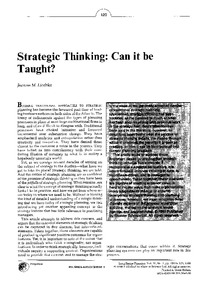Strategic thinking: can it be taught?

1998
31
1
120-129
management strategy ; decision making ; training ; creative thinking
Education and training
https://doi.org/10.1016/S0024-6301(97)00098-8
English
Bibliogr.
"In the wake of the generally accepted demise of traditional strategic planning approaches, strategic thinking has been heralded as the panacea to much of what has been seen as wrong with previous work in the strategy field. Scant attention has been paid in the literature, however, to describing specifically what the process of strategic thinking entails, the means through which it produces the benefits it is seen as creating, or how it can be incorporated into current planning practices.
This article seeks to address these important issues by arguing that strategic thinking includes five elements: it incorporates a systems perspective, it is intent-focused, involves thinking in time, is hypothesis-driven, and is intelligently opportunistic. Taken together, these elements are capable of creating superior value, in hard to initiate ways, that make organizations more adaptable to change. In order to incorporate strategic thinking into planning processes, however, we must recognize three discrete aspects of the process: repertoire-building, managing the strategic issues agenda, and programming."
Digital
The ETUI is co-funded by the European Union. Views and opinions expressed are however those of the author(s) only and do not necessarily reflect those of the European Union or the ETUI.